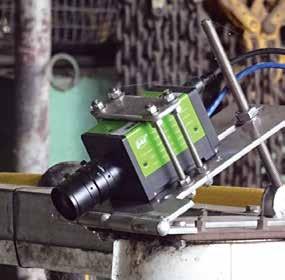
3 minute read
MAXIMISING THE VALUE OF A CANE CROP IN A MILLING AREA
(Above) RGB colour image of cane billets coming into Tully Sugar Mill. (Below) NIR image of cane billets.

Advertisement
MAXIMISING THE VALUE
OF A CANE CROP IN A MILLING AREA
Apersistent thorny question for both the growing and the milling sectors of the industry has been the economic value lost to a milling area of the amount of ‘rubbish’ (extraneous matter or EM) that is harvested with the cane and sent to the mill for processing.
Why is this figure important?
QUT researcher Ross Broadfoot said high levels of extraneous matter add substantially to the costs of milling operations.
This is “because of less cane to process per bin causing reduced crushing rates, delays caused by milling stoppages due to chokes, and consequently extended season lengths,” Ross said.
“In addition, EM can reduce the amount of sugar that can be processed from each tonne of cane due to sugar recovery and liquid purity challenges. “These are impacts that decrease the value of a cane crop to a milling area affecting both miller and grower returns,” he said.
“However, up until now it has not been technically possible nor financially feasible to measure the size of the problem. Without being able to measure it the true costs of harvesting EM cannot be determined.”
That has changed with a new project presented at the QUT/SRA Regional Milling Research Seminars - On-line measurement of the physical properties of each cane consignment at the factory - which has developed a way to measure the physical properties of individual rakes of cane using equipment costing only about $15,000.
The project has drawn on the expertise at Tully Mill where EM is already being manually measured and where millers and growers already take a cooperative approach to managing cane harvesting, transport and milling operations to maximise the value of the cane crop for the district.
A camera and lights have been set up by QUT researchers in a strategic position at Tully Mill to take an image every 20 seconds of each bin of cane which has arrived in the mill.
Ross Broadfoot


The recorded vision data has been linked to the cane receival data through the mill’s cane tracking system.
At the same time, a small sorting station at Tully Mill – known by staff as the ‘billet box’ – has manually segregated grab samples of cane from the same bins into the various components – stools, tops, trash and billets. A dedicated computer has stored the mill data – billet box data, consignment identification and timestamp - and aligned it with the captured imagery.
This data will be used to develop a machine which could learn to estimate billet dimensions and extraneous matter in a cane rake given a set of images of the rake.
In this way, parameters such as the EM level and the cane billet dimensions can be routinely monitored. “This project will give the mills the specifications for the required video equipment to be installed above the cane carrier for measurement of EM percentages and billet dimensions based on the developed algorithms,” Ross said.
“On-line measurement of the physical properties of the cane supply, used with harvesting information such as field loss estimates and transport information such as bin weights will enable optimum harvesting conditions to be determined which would maximise cane value in each district.
“The financial benefits to a cane district from implementing the technology will of course vary across the industry. Differences in cane varieties, crop intensity, green or burnt cane and haulage distances are just some of the factors that will have to be considered to determine the preferred physical attributes of the cane supply. However, for a district crushing green cane the net benefit in terms of increased income and reduced costs is estimated as at $3-$4 per tonne of cane.
“At Tully Mill where EM is manually measured, many growers have shown they are keen to know the EM content in their supplied cane since they are not paid for transporting EM to the mill. Systems that embrace a cooperative use of the data and financial modelling for each district will be valuable in maximising the benefit for all.”










